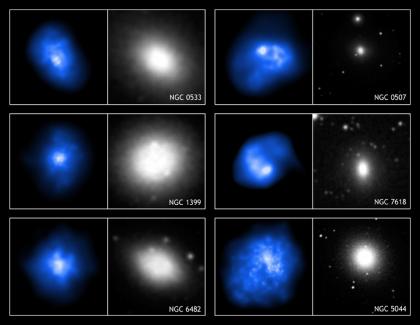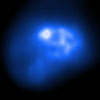NGC 0507:
Black Holes Stir Up Galaxies
 Credit: X-ray: NASA/CXC/U. Ohio/T.Statler & S.Diehl; Optical: DSS
Credit: X-ray: NASA/CXC/U. Ohio/T.Statler & S.Diehl; Optical: DSS
Chandra images of 56 elliptical galaxies have revealed evidence for
unsuspected turmoil. As this sample gallery of X-ray (blue & white) and
optical (gray & white) images shows, the shapes of the massive clouds of
hot gas that produce X-ray light in these galaxies differ markedly from
the distribution of stars that produce the optical light.
Except for rare cases, most violent activity in isolated elliptical
galaxies was thought to have stopped long ago. Elliptical galaxies
contain very little cool gas and dust, and far fewer massive young stars
which explode as supernovas. Thus it was expected that the hot
interstellar gas would have settled into an equilibrium shape similar
to, but rounder than that of the stars.
Surprisingly, this study of elliptical galaxies shows that the
distribution of hot gas has no correlation with the optical shape. A
powerful source of energy must be pushing the hot gas around and
stirring it up every hundred million years or so.
Although supernovas are a possible energy source, a more probable cause
has been identified. The scientists detected a correlation between the
shape of the hot gas clouds and the power produced at radio wavelengths
by high-energy electrons. This power source can be traced back to the
supermassive black hole in the galaxies' central regions.
Repetitive explosive activity fueled by the infall of gas into the
central supermassive black hole is known to occur in giant elliptical
galaxies located in galaxy clusters. Scientists' analysis of the Chandra
data indicates that the same phenomena are occurring in isolated
elliptical galaxies as well.
| Fast Facts for NGC 0507: |
| Credit |
X-ray: NASA/CXC/U. Ohio/T.Statler & S.Diehl; Optical: DSS |
| Scale |
Image is 3.4 arcmin across. |
| Category |
Normal Galaxies & Starburst Galaxies |
| Coordinates (J2000) |
RA 01h 23m 39.00s | Dec +33º 15' 24.00" |
| Constellation |
Pisces
|
| Observation Dates |
11 October 2000 |
| Observation Time |
8 hours |
| Obs. IDs |
317
|
| Color Code |
Intensity |
| Instrument |
ACIS |
| References | T. Statler and S.Diehl, 2006, "Morphology of the Hot ISM in Normal Elliptical Galaxies: A Chandra Gas Gallery" Bulletin of the American Astronomical Society |
| Distance Estimate |
About 234 million light years
|
| Release Date |
January 10, 2006 |
|
| Fast Facts for NGC 5044: |
| Credit |
X-ray: NASA/CXC/U. Ohio/T.Statler & S.Diehl; Optical: DSS |
| Scale |
Image is 4.75 arcmin across. |
| Category |
Normal Galaxies & Starburst Galaxies |
| Coordinates (J2000) |
RA 13h 15m 24.00s | Dec -16º 23' 06.40" |
| Constellation |
Virgo
|
| Observation Dates |
19 March 2000 |
| Observation Time |
6 hours |
| Obs. IDs |
798
|
| Color Code |
Intensity |
| Instrument |
ACIS |
| References | T. Statler and S.Diehl, 2006, "Morphology of the Hot ISM in Normal Elliptical Galaxies: A Chandra Gas Gallery" Bulletin of the American Astronomical Society |
| Distance Estimate |
About 102 million light years
|
| Release Date |
January 10, 2006 |
|
| Fast Facts for NGC 1399: |
| Credit |
X-ray: NASA/CXC/U. Ohio/T.Statler & S.Diehl; Optical: DSS |
| Scale |
Image is 1.5 arcmin across. |
| Category |
Normal Galaxies & Starburst Galaxies |
| Coordinates (J2000) |
RA 03h 38m 29.40s | Dec -35º 27' 00.40" |
| Constellation |
Fornax
|
| Observation Dates |
18 January 2000 |
| Observation Time |
16 hours |
| Obs. IDs |
319
|
| Color Code |
Intensity |
| Instrument |
ACIS |
| References | T. Statler and S.Diehl, 2006, "Morphology of the Hot ISM in Normal Elliptical Galaxies: A Chandra Gas Gallery" Bulletin of the American Astronomical Society |
| Distance Estimate |
About 65 million light years
|
| Release Date |
January 10, 2006 |
|
| Fast Facts for NGC 0533: |
| Credit |
X-ray: NASA/CXC/U. Ohio/T.Statler & S.Diehl; Optical: DSS |
| Scale |
Image is 1.4 arcmin across. |
| Category |
Normal Galaxies & Starburst Galaxies |
| Coordinates (J2000) |
RA 01h 25m 31.40s | Dec +01º 45' 32.80" |
| Constellation |
Cetus
|
| Observation Dates |
28 July 2002 |
| Observation Time |
11 hours |
| Obs. IDs |
2880
|
| Color Code |
Intensity |
| Instrument |
ACIS |
| References | T. Statler and S.Diehl, 2006, "Morphology of the Hot ISM in Normal Elliptical Galaxies: A Chandra Gas Gallery" Bulletin of the American Astronomical Society |
| Distance Estimate |
About 253 million light years
|
| Release Date |
January 10, 2006 |
|
| Fast Facts for NGC 7618: |
| Credit |
X-ray: NASA/CXC/U. Ohio/T.Statler & S.Diehl; Optical: DSS |
| Scale |
Image is 2.4 arcmin across. |
| Category |
Normal Galaxies & Starburst Galaxies |
| Coordinates (J2000) |
RA 23h 19m 47.30s | Dec +42º 51' 07.70" |
| Constellation |
Andromeda
|
| Observation Dates |
10 December 1999 |
| Observation Time |
5 hours |
| Obs. IDs |
802
|
| Color Code |
Intensity |
| Instrument |
ACIS |
| References | T. Statler and S.Diehl, 2006, "Morphology of the Hot ISM in Normal Elliptical Galaxies: A Chandra Gas Gallery" Bulletin of the American Astronomical Society |
| Distance Estimate |
About 251 million light years
|
| Release Date |
January 10, 2006 |
|
| Fast Facts for NGC 6482: |
| Credit |
X-ray: NASA/CXC/U. Ohio/T.Statler & S.Diehl; Optical: DSS |
| Scale |
Image is 1.45 arcmin across. |
| Category |
Normal Galaxies & Starburst Galaxies |
| Coordinates (J2000) |
RA 17h 51m 48.90s | Dec +23º 04' 19.00" |
| Constellation |
Hercules
|
| Observation Dates |
20 May 2002 |
| Observation Time |
5 hours |
| Obs. IDs |
3218
|
| Color Code |
Intensity |
| Instrument |
ACIS |
| References | T. Statler and S.Diehl, 2006, "Morphology of the Hot ISM in Normal Elliptical Galaxies: A Chandra Gas Gallery" Bulletin of the American Astronomical Society |
| Distance Estimate |
About 192 million light years
|
| Release Date |
January 10, 2006 |
|






